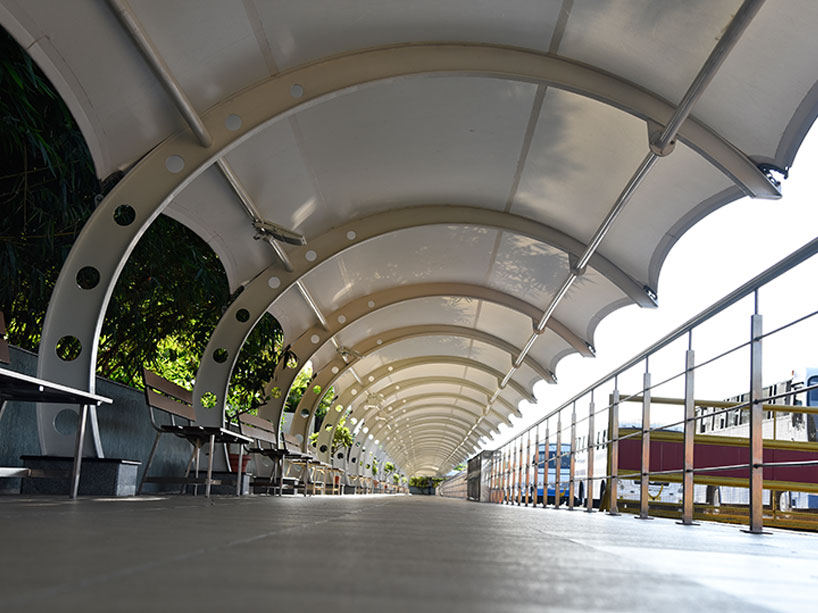Overview
Tensile structures use a stretched fabric material in a three-dimensional surface, which can potentially create shading, roof, and decorative components by tensioning it to the cables.
They are also constructed using a specialized fabric that is put into tension such that the self-weight can be easily supported. Besides this, they can eventually take care of the load and provide very cost-effective solutions and indeed cover vast distances without any intermediate supports.
A fabric material in general consists of three essential components, i.e., coating, fabric substrate, and the top coating. Today in the following blog, we would be covering the properties, types, and advantages of Tensile Structures. So, let us have a look at it in the paragraphs to follow: –
What are the properties of tensile structures?
There are many properties of tensile structure. Some of them has mentioned below: –
- Tensile Strength
Tensile strength is known to be the primary indicator of relative stability. It is perhaps fundamental for the architectural fabrics that primarily function in tension.
2. Tear Strength
If a fabric breaks down, then tear strength is quite important to consider. In general, it does so by tearing.
3. Flame Retardancy
The fabric with flame-retardant coating present in it is likely to withstand the hot point source quite easily. However, if there is a large ignition source present, then chances are that it can still get burned.
4. Flexibility
Tensile fabric structure can use very well in building construction because of its flexibility.
5. Adhesion Strength
It is the measure of the bond strength between the coating and the base material. It is quite useful in measuring the welded joints strength for connecting the fabric strips into the fabricated assembly.
What are the different types of fabrics that are used in Tensile Structures?
Tensile Fabric structures are manufactured using fabric rather than films or meshes. In general, the fabric is laminated and coated using synthetic materials such that the durability, strength, and environmental resistance are increased. Some of the different types of fabrics that are used in tensile structures are: –
- Cotton Canvas
This is indeed one of the standards and oldest used fabric materials used to make the tents and shades. It can either be light canvas, light cotton twill, or a heavy proofed canvas.
2. Polyesters
Polyesters with many properties such as durability, strength, and stretch make polyester the most widely used fabric structure. In general, polyesters are coated and laminated with PVC films, which are considered affordable for longer-term fabrications. Polyesters fabrics come up in two types that have been mentioned below: –
# Vinyl-Coated Polyesters
Vinyl-coated polyester is composed using an adhesive agent, polyester scrim, and an exterior PVC coating. It is perhaps the most frequently used material that is used in flexible fabric structures.
#Vinyl-Laminated Polyesters
Laminated fabric is, in general, composed using polyester scrim that is pressed between two layers of an unsupported PVC film. It also refers to two layers of material joined together using pressure, heat, and an adhesive such that a single ply is formed.
3. Fiberglass
The fiberglass that is coated alongside PTFE is also quite widely used as a base material. Continuous filaments are being used to draw the glass fibers, which are further put together into yarns. The yarns are additionally woven to make up the substrate. The fiberglass is known to have significant tensile strength, and it can behave elastically, and it doesn’t suffer from considerable stress relaxation.
Fiberglass fabrics are divided into two types, i.e., polyolefin fabric, ePTFE woven, and Polyvinylidene fluoride woven.
4. Blackout Fabric
Blackout fabric is an opaque material with a laminate present in it, which eventually sandwiches the opaque layer between the two white exterior layers. Lighting and heating of the structure can be easily controlled as the fabric doesn’t allow the light to pervade the walls or top. Besides, it also helps prevent the dirt, strains, and repairs from being noticed from the inside.
What are the various categories of the Top coating for the Tensile Structures?
The top coating comes up with a hard surface present on the outside of the material and thus acts as a barrier that helps prevent the dirt from sticking to different materials. This potentially helps to clean the fabric quite easily using water. To topcoat the fabric, different kinds of materials are being used. Some of them have been mentioned below: –
- PVDF top coating
- PVF film lamination
- Titanium Dioxide Top coating
- PVC top coating
What are the advantages of Tensile Structures?
There are many advantages of Tensile Structures. Some of them has mentioned below: –
- Coverage
Tensile fabric structures can be very well used for expansive coverage of the area. Tensile fabric structures, in general, require minimum support, and they provide a large open space underneath such that the covered area is fully used.
2. Visual
The tensile fabric structure is quite versatile in design and shape, and at the same time, it is very lightweight. It comes up with a unique kind of dynamics as well as three-dimension options.
Tensile fabric structures can be used for creating a visual focus of attention, and thus a dynamic impact is provided. It can also be used for imaginative designs as only a few components are needed to create a structure.
3. Versatile
Tensile fabric structures are quite versatile in design, and hence it can be an ideal solution for many applications. It can be used in creating walkways, canopies, shade sails, and outdoor dining canopies, to name a few.
4. Colors
The tensile fabric structure is available in a wide range of colors, and appealing canopies can be easily created using the tensile fabric structure.

